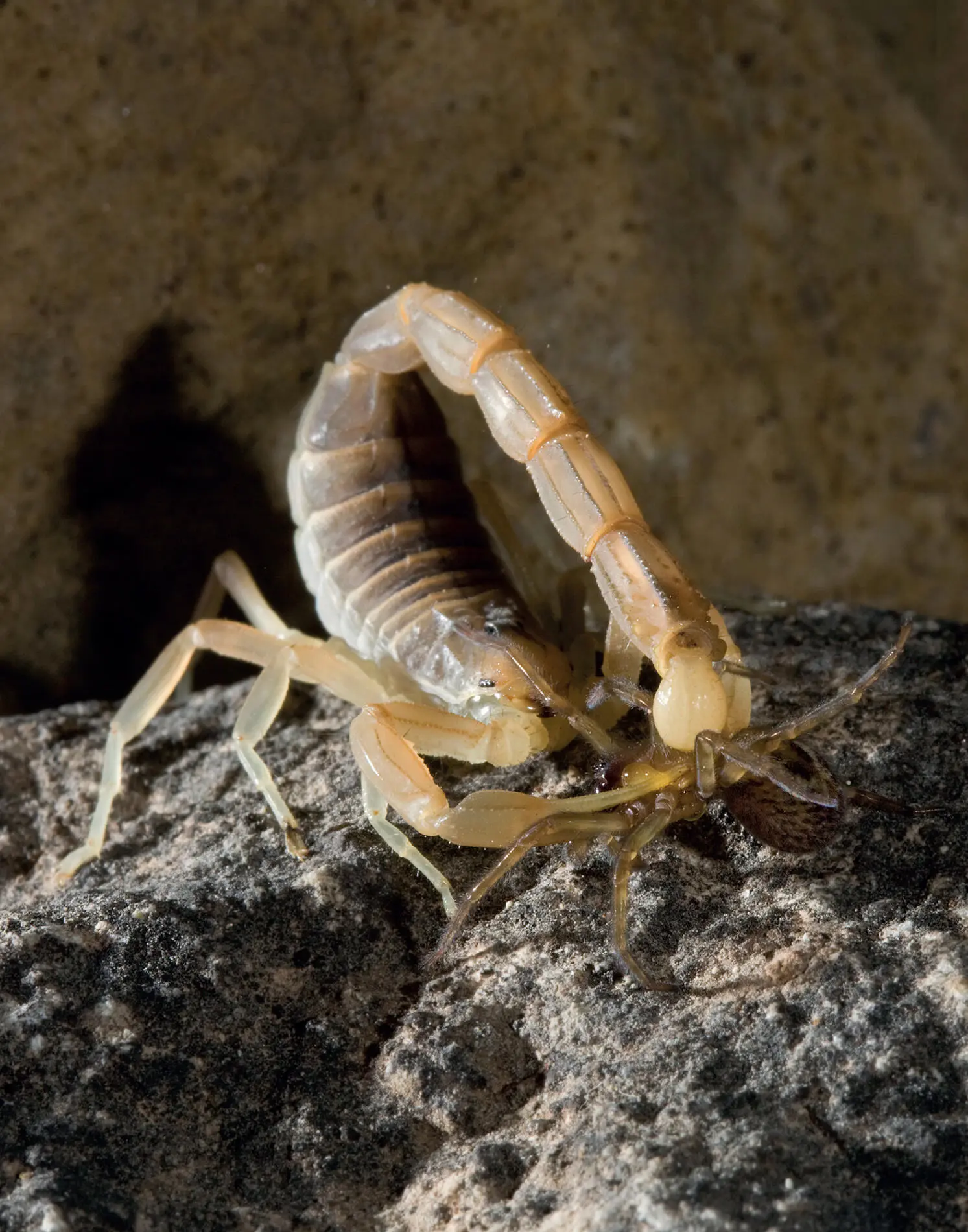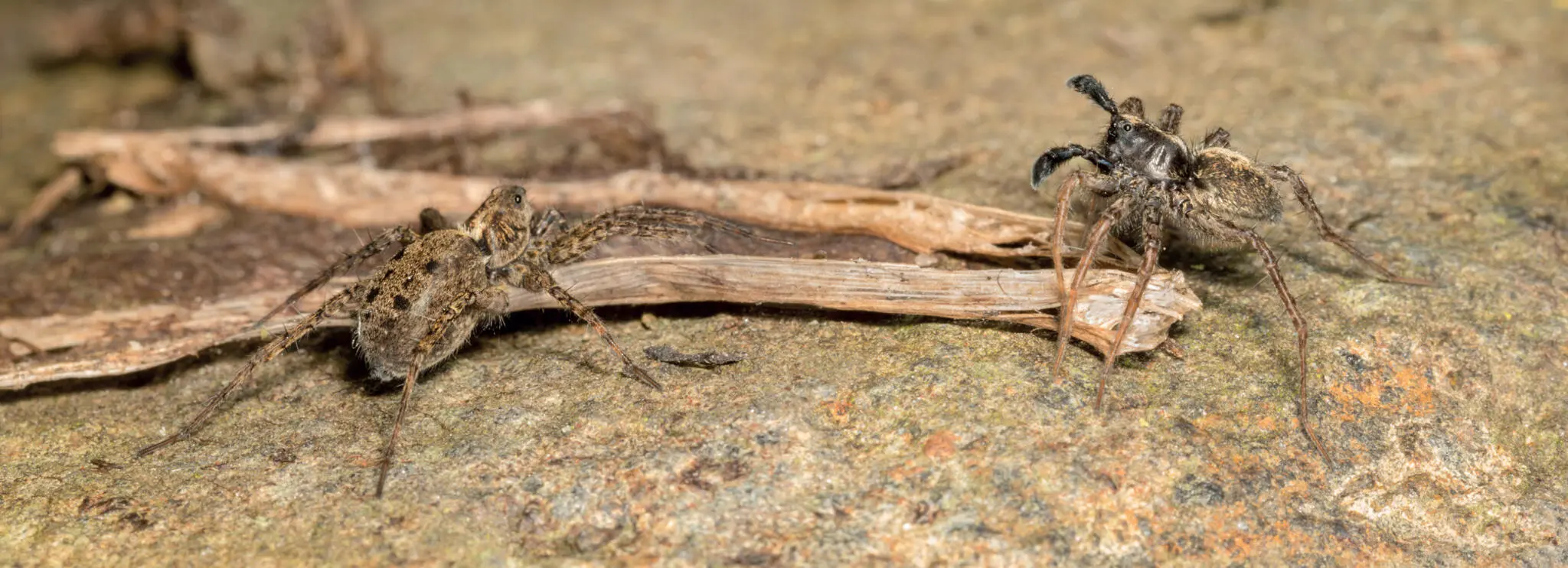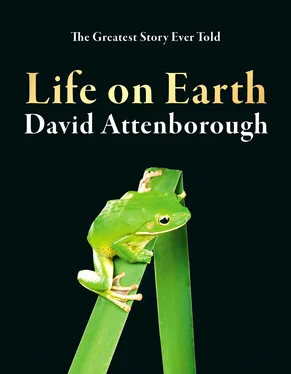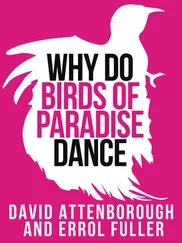The external skeleton inherited from their water-living forebears needed few modifications for life on land, but the millipedes did have to acquire a different method of breathing. The feathery gill attached to a stalk alongside the leg that had served their aquatic relatives, the crustaceans, would not work in air. In its place, the millipedes developed a system of breathing tubes, the tracheae. Each tube begins at an opening on the flank of the shell and then branches internally into a fine network that leads ultimately to all the organs and tissues of the body, the tips even entering individual specialised cells called tracheoles that deliver gaseous oxygen to the surrounding tissues and also absorb waste.
Reproduction out of water, however, posed problems for the millipedes. Their marine ancestors had relied, like the algae, on water to enable their sperm to reach their eggs. On land the solution was an obvious one – male and female, being well able to move about, must meet and transfer the sperm directly from one to the other. This is exactly what millipedes do. Both sexes house their reproductive cells in glands close to the base of the second pair of legs. When the male meets the female in the mating season, the two intertwine. The male reaches forward with his seventh leg, collects a bundle of sperm from his sex gland and then clambers alongside the female until the bundle is beside her sexual pouch and she is able to take it in. The process looks rather laborious but at least it is not dangerous. Millipedes are entirely vegetarian. Fiercer invertebrates, which came to the moss jungles to prey on this grazing population of millipedes, could not indulge in such trusting relationships.
Three groups of these predatory creatures still survive today – centipedes, scorpions and spiders. Like their prey, they are members of the segmented group of animals, though the degree to which they have retained divisions in their bodies varies considerably. The centipedes are as clearly and extensively segmented as their close relatives the millipedes. The scorpions show divisions only in their long tails; and most spiders have completely lost all signs of segmentation, except for a few Southeast Asian species which retain clearly recognisable relics of their segmented past.
The scorpions that live today have not only fearsome-looking claws but a large venom gland drooping from the end of a long thin tail with a sharp curving sting. Their copulations cannot be the somewhat hit-and-miss gropings practised by the millipedes. Approaching such an aggressive and powerful creature is a dangerous enterprise even if the move is made by another individual of the same species and its intentions are purely sexual. There is a real risk of it being regarded not as a mate but a meal. So scorpion mating demands, for the first time among the animals that have appeared so far in this history, the ritualised safeguards and placations of courtship.
The male scorpion approaches the female with great wariness. Suddenly he grabs her pincers with his. Thus linked, with her weapons neutralised, the pair begin to dance. Backwards and forwards they move with their tails held upright, sometimes even intertwined. After some time, their shuffling steps have cleared the dancing ground of much of its debris. The male then extrudes a packet of sperm from the genital opening beneath his thorax and deposits it on the ground. Still grasping the female by the claws, he jerks and heaves her forward until her sexual opening, also on her underside, is brought directly above the sperm packet. She takes it up, the partners disengage and then go their separate ways. The eggs eventually hatch inside the mother’s pouch, the young crawl out and clamber up on to her back. There they stay for about a fortnight until they have completed their first moult and can fend for themselves.

Mediterranean/European scorpion ( Buthus occitanus ) stinging a spider ( Amourobius sp.).
Spiders, too, must be extremely cautious in their courtship. Matters are made even more hazardous for the male because he is nearly always smaller than the female. And he prepares for his encounter with his mate long before he meets her. He spins a tiny triangle of silk a few millimetres in length and deposits a drop of sperm on to it from the gland that lies underneath his body. He then sucks it into the hollow first joint of his pedipalp, a special limb at the front of his body. Now he is ready.
The courtships of spiders are beguilingly various and ingenious. Jumping spiders and wolf spiders hunt primarily by sight and have excellent eyes. The courting male, consequently, relies on visual signals to make the female aware of his presence and his purpose. His pedipalps are brightly coloured and patterned, and as soon as he sights a female, he begins to signal with them in a kind of manic semaphore. Nocturnal spiders, on the other hand, depend largely on an extremely delicate sense of touch to find their prey. When they meet one another, they gingerly caress each other’s long legs, and only after a great deal of hesitation do they come to closer quarters. Web-making spiders are sensitive to the vibrations on their silken threads that tell them when a victim has blundered into the web. So when the male of such a species approaches a female hanging, large and menacing, on her web, or lurking hidden beside it, he signals to her by twanging the threads at one side in a special and meaningful way which he trusts the female will recognise. Other species put their faith in bribery. The male catches an insect and carefully parcels it up in silk. Holding this in front of him, he cautiously approaches the female and presents it to her. While she is occupied in examining the gift, he quickly scuttles over her and ties her to the ground with bonds of silk. Only then does he risk an embrace.
All these techniques lead to the same conclusion. The male, having survived every danger, places his pedipalp close to the female’s genital opening, squirts out the sperm and then hastily retreats. It has to be recorded that in spite of all his precautions he sometimes fails to make his getaway in time and the female eats him after all. But in terms of the transmission of his genes, the male’s disaster is of limited consequence: he lost his life after, not before, he had completed his purpose.
While the early segmented animals were perfecting their adaptations for living on land and away from moisture, the plants were also changing. Neither the mosses nor the other early forms had true roots. Their short upright stems sprang from a horizontal one of a similar character lying along the ground or just below it. This construction served well enough in moist surroundings, but in many parts of the world the only permanent water supply lies below the ground. To tap that requires roots that probe deep between the particles of the soil and can absorb the film of water that clings to them in all except the most arid environments. Three groups of plants appeared that possessed such structures, and all three have descendants that have survived without much change: club mosses, which resemble mosses but have stiffer stems; horsetails, which grow in waste patches and ditches and have stems encircled at intervals with rings of needle-like leaves; and ferns.

Wolf spiders ( Pardosa sp.), male (right) waving palps in courtship display, Derbyshire, UK.
The ferns, early in their history, had developed a special protein to protect themselves from damage by ultraviolet light, something that had not been a problem for their ancestors since they lived in water where such wavelengths could not reach them. This substance now slowly changed into a material called lignin. This is the basis of wood, and it gave them the rigidity needed to grow tall. So a new kind of competition developed between plants.
Читать дальше














